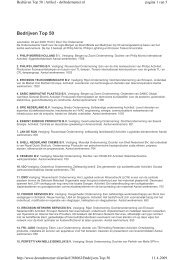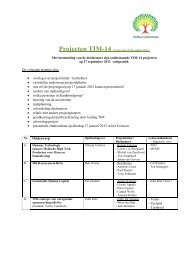The Triple Helix of university–industry–government relations
The Triple Helix of university–industry–government relations
The Triple Helix of university–industry–government relations
Create successful ePaper yourself
Turn your PDF publications into a flip-book with our unique Google optimized e-Paper software.
L. LEYDESDORFF, M. MEYER: <strong>The</strong> <strong>Triple</strong> <strong>Helix</strong> <strong>of</strong> <strong>university–industry–government</strong> <strong>relations</strong><br />
social realities and in terms <strong>of</strong> the representations that can be constructed at the<br />
localizable interfaces. Systems <strong>of</strong> innovations solve the puzzles <strong>of</strong> how to interface<br />
different functions in the communication. <strong>The</strong>se solutions and failures are manifest at<br />
the level <strong>of</strong> historical organization. However, the historical manifestations can be<br />
reshaped evolutionarily.<br />
Evolutionary economists, secondly, have argued in favor <strong>of</strong> studying ‘national<br />
systems <strong>of</strong> innovation’ as another model. Indeed, they have provided strong arguments<br />
for this level as most relevant for the integration (LUNDVALL, 1992; NELSON, 1993;<br />
SKOLNIKOFF, 1993). However, these systems are continuously being restructured under<br />
the pressure <strong>of</strong> the global differentiation <strong>of</strong> expectations. For example, the transnational<br />
framework <strong>of</strong> the European Union has provided subnational regions with access to new<br />
resources (LEYDESDORFF et al., 2002). Others have argued that new technologies drive<br />
the shaping <strong>of</strong> new systems <strong>of</strong> innovation (CARLSSON & STANKIEWICZ, 1991).<br />
Economies are interwoven at the level <strong>of</strong> markets and in terms <strong>of</strong> multinational<br />
corporations, sciences are organized internationally, and governance is no longer<br />
limited within national boundaries. <strong>The</strong> most interesting innovations can be expected to<br />
involve boundary-spanning mechanisms (e.g., the EU, the entrepreneurial university,<br />
new technologies, etc.). In sum, we concur with the ‘Mode 2’-model in assuming a<br />
focus on communication as the driver <strong>of</strong> systems <strong>of</strong> organized knowledge production<br />
and control. However, the problem <strong>of</strong> structural differences among the communications<br />
and the organization <strong>of</strong> interfaces remains crucial to the understanding <strong>of</strong> innovation in<br />
a knowledge-based economy. <strong>The</strong> accumulated knowledge and options for further<br />
developments have to be retained by reorganizing institutional arrangements with<br />
reference to global markets.<br />
<strong>The</strong> <strong>Triple</strong> <strong>Helix</strong>: an empirical program<br />
<strong>The</strong> <strong>Triple</strong> <strong>Helix</strong> model <strong>of</strong> <strong>university–industry–government</strong> <strong>relations</strong> tries to capture<br />
the dynamics <strong>of</strong> both communication and organization by introducing the notion <strong>of</strong> an<br />
overlay <strong>of</strong> exchange <strong>relations</strong> that feeds back on the institutional arrangements. <strong>The</strong><br />
institutions and their <strong>relations</strong> provide a knowledge infrastructure that (paradoxically)<br />
carries the knowledge base. Each <strong>of</strong> the helices develops internally, but they also<br />
interact in terms <strong>of</strong> exchanges <strong>of</strong> both goods and services, and in terms <strong>of</strong> their<br />
functions. Functional and institutional roles can be traded <strong>of</strong>f on the basis <strong>of</strong><br />
knowledge-based expectations as in the case <strong>of</strong> the “entrepreneurial university”<br />
(ETZKOWITZ et al., 2000).<br />
196 Scientometrics 58 (2003)







